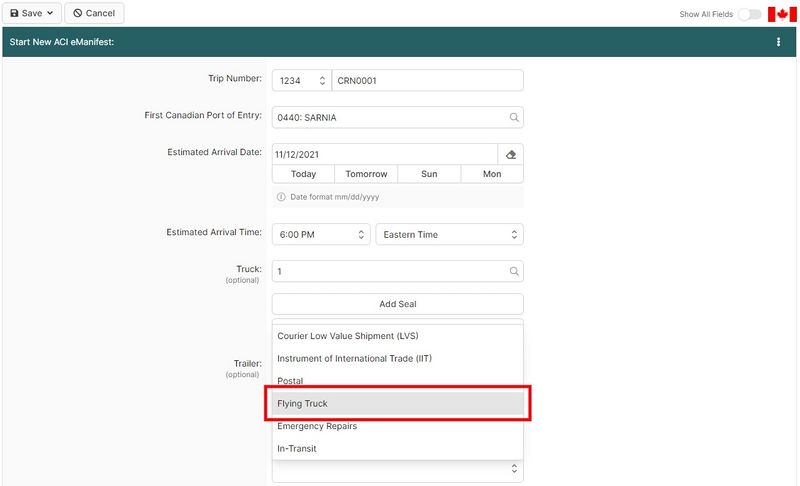Flying Truck (CBSA Cargo Exemption): Difference between revisions
(Created page with "{{note|This article is part of the Shipment Release Types Guide|info}} {{#ev:youtube|zyMyAJoWSY8|960|center|How to create IIT and cargo exemptions in ACI.}}<onlyinclude>'''Flying Truck''' is a Canadian Shipment Type for goods to clear through CBSA and [https://www.borderconnect.com/aci-e-manifest/index.htm ACI eManifest]. It a...") |
No edit summary |
||
| Line 13: | Line 13: | ||
In addition to including the Flying Truck exception code on the ACI eManifest, the driver is required to present the air carrier's paper documents, including air waybill completed with the air carrier's cargo control number, to the officer when arriving at the border. The shipment must then be delivered to a sufferance warehouse license to receive air cargo. <ref>Customs Memorandum D3-2-2 http://www.cbsa-asfc.gc.ca/publications/dm-md/d3/d3-2-2-eng.pdf</ref></onlyinclude> | In addition to including the Flying Truck exception code on the ACI eManifest, the driver is required to present the air carrier's paper documents, including air waybill completed with the air carrier's cargo control number, to the officer when arriving at the border. The shipment must then be delivered to a sufferance warehouse license to receive air cargo. <ref>Customs Memorandum D3-2-2 http://www.cbsa-asfc.gc.ca/publications/dm-md/d3/d3-2-2-eng.pdf</ref></onlyinclude> | ||
{{reminder|In order to comply with ACI eManifest requirements you are required to ensure that both your manifest and the broker clearance on any PARS shipments are on file with CBSA for at least one hour before the driver arrives at the border.}} | |||
{ | |||
| In order to comply with ACI eManifest requirements you are required to ensure that | |||
== References == | == References == | ||
Revision as of 12:30, 6 June 2023
| This article is part of the Shipment Release Types Guide |
Flying Truck is a Canadian Shipment Type for goods to clear through CBSA and ACI eManifest. It allows for the release of shipments arriving at the border by highway carrier that were originally supposed to arrive by air and have been already been declared on an ACI eManifest for the air mode of transportation. Because the cargo has already been reported in ACI by the air carrier, it is afforded special processing under Flying Truck when it arrives by highway carrier.
Declaring Flying Truck in ACI eManifest
Flying Truck shipments are required to be reported on an ACI eManifest. To report a Flying Truck shipment the carrier will need to set the flying truck exception code on either the truck, trailer or container, depending on where the shipment is loaded. This tells Customs that there is a Flying Truck shipment aboard. The carrier will not create an ACI Shipment to report the Flying Truck Shipment, it must be reported using the exception code only. The example below shows how to report Flying Truck shipments using BorderConnect's ACI eManifest software.[1][2]
If a Flying Truck Shipment is the only thing being transported, the carrier can transmit the ACI eManifest with only the trip (conveyance) portion, and no ACI Shipments attached. Otherwise, the other shipments can be added and the manifest can be transmitted normally.
In addition to including the Flying Truck exception code on the ACI eManifest, the driver is required to present the air carrier's paper documents, including air waybill completed with the air carrier's cargo control number, to the officer when arriving at the border. The shipment must then be delivered to a sufferance warehouse license to receive air cargo. [3]
| In order to comply with ACI eManifest requirements you are required to ensure that both your manifest and the broker clearance on any PARS shipments are on file with CBSA for at least one hour before the driver arrives at the border. |
References
- ↑ CBSA Requirements for Commercial Clients http://www.cbsa-asfc.gc.ca/prog/manif/requirements-exigences-eng.html
- ↑ ACI eManifest Highway ECCRD http://www.cbsa-asfc.gc.ca/prog/manif/eccrd-decce-1-eng.pdf
- ↑ Customs Memorandum D3-2-2 http://www.cbsa-asfc.gc.ca/publications/dm-md/d3/d3-2-2-eng.pdf

